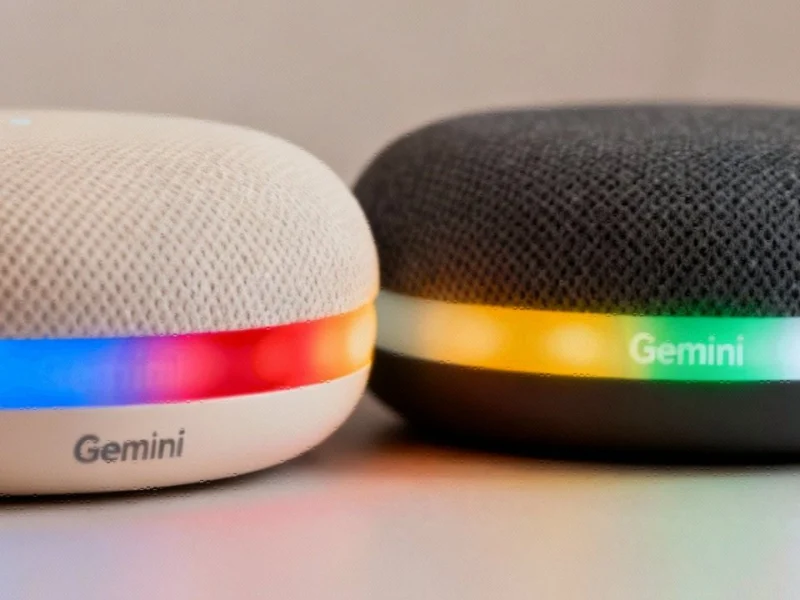Subtle Visual Cues Herald Major AI Transformation
Google has begun implementing a significant visual overhaul for its Nest speaker lineup, with devices now displaying a vibrant color spectrum when activated rather than the traditional white glow. This seemingly cosmetic change actually represents the first visible sign of Google’s broader strategy to align its smart home ecosystem with the Gemini AI platform, marking a fundamental shift in how these devices will interact with users moving forward.
The new lighting pattern—which cycles through blue, red, yellow, and green before returning to white—directly mirrors Gemini’s branding colors. This visual synchronization suggests that Google is preparing users for a more integrated AI experience, where Nest devices transition from simple voice assistants to sophisticated AI companions. As reported by industry analysts, this change represents just the beginning of Google’s ambitious smart home transformation.
Behind the Colorful Facade: Technical Implementation
Currently available only to Preview Program participants running firmware version 3.77.500695, the update affects both Nest Mini and Nest Audio models. The visual effect is particularly striking on Chalk and Charcoal colored units, where the color transitions create a more dynamic interaction experience. While the lighting changes might appear purely aesthetic, they coincide with reported alterations in voice response patterns, device pairing behavior, and overall speaker functionality.
Google’s approach follows a pattern seen in other technology sectors, where visual changes often precede functional upgrades. This gradual implementation allows users to acclimate to the new AI-driven ecosystem before more substantial behind-the-scenes enhancements are introduced.
The Road to Gemini: Strategic Implications
With Gemini’s official Home device debut scheduled for October 28 in the United States, these visual modifications serve as an onboarding mechanism for the upcoming AI transition. Google appears determined to position Nest devices as active AI partners rather than passive audio equipment, a strategic move that aligns with broader industry developments in artificial intelligence integration.
The transition from Google Assistant to Gemini represents one of the most significant shifts in Google’s smart home strategy in recent years. While the migration process remains gradual—with not all users receiving immediate updates—the direction is clear: Nest hardware is becoming the frontline showcase for Google’s AI ambitions. This evolution reflects similar market trends toward more personalized and visually communicative smart devices.
User Experience and Industry Context
Early adopters have noted that the colorful light displays make interactions with Nest speakers feel more engaging and responsive. This enhanced user experience demonstrates how subtle design changes can significantly impact device perception, much like how other related innovations in technology have focused on improving user engagement through visual feedback.
The timing of this rollout suggests Google is carefully staging its AI implementation, using visual cues to build anticipation and familiarity before introducing more advanced Gemini features. This measured approach to ecosystem transformation mirrors strategies seen in other recent technology deployments, where user adaptation is prioritized alongside functional upgrades.
Looking Ahead: The Future of AI-Integrated Smart Homes
As Google continues to refine its Nest-Gemini integration, users can expect more substantial changes in how they interact with their smart home devices. The colorful lighting scheme represents just the initial layer of what will likely become a comprehensive AI-driven experience, with future updates potentially including more natural language processing, predictive behaviors, and contextual awareness.
This transition positions Google to compete more effectively in the increasingly crowded smart home market, where AI capabilities are becoming a key differentiator. As Gemini becomes more deeply embedded in daily routines, these initial visual changes will likely be remembered as the first visible step toward a more intuitive and responsive smart home ecosystem.
The bottom line: While the new colorful lights provide an immediate visual refresh for Nest speakers, their true significance lies in what they represent—the beginning of Google’s ambitious plan to transform smart home devices into genuine AI companions, with Gemini at the core of this evolving relationship between users and their technology.
This article aggregates information from publicly available sources. All trademarks and copyrights belong to their respective owners.



